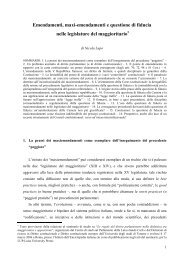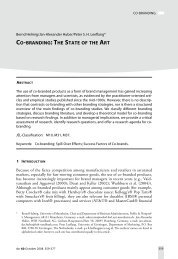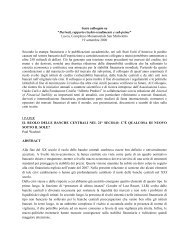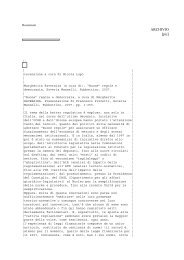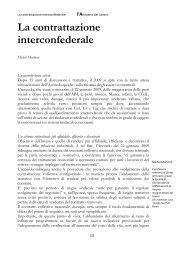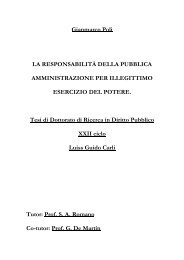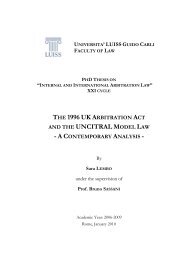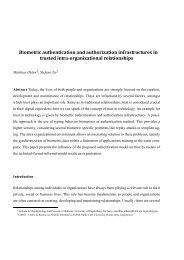The rebates, which consist in granting a lump sum discount to the ...
The rebates, which consist in granting a lump sum discount to the ...
The rebates, which consist in granting a lump sum discount to the ...
Create successful ePaper yourself
Turn your PDF publications into a flip-book with our unique Google optimized e-Paper software.
<strong>to</strong> capture. <strong>The</strong>n it compares <strong>the</strong>se two elements <strong>to</strong> assess whe<strong>the</strong>r <strong>the</strong> required share exceeds <strong>the</strong>commercially viable share: if it does, it would mean that <strong>the</strong> rebate system would likely <strong>to</strong> have <strong>the</strong>foreclosure effect on <strong>the</strong> market. This is because it would be equivalent <strong>to</strong> say that <strong>the</strong> effectiveprice applied by <strong>the</strong> dom<strong>in</strong>ant company is below <strong>the</strong> average <strong>to</strong>tal cost of <strong>the</strong> dom<strong>in</strong>ant company.However, even <strong>in</strong> case a cost based test is applied <strong>to</strong> one of <strong>the</strong> most complex type of rebate such asloyalty <strong>rebates</strong>, <strong>the</strong> positive f<strong>in</strong>d<strong>in</strong>g regard<strong>in</strong>g <strong>the</strong> likel<strong>in</strong>ess of <strong>the</strong> foreclosure will not be sufficient<strong>to</strong> state confidently that <strong>the</strong>re is an abuse of dom<strong>in</strong>ant position by <strong>the</strong> dom<strong>in</strong>ant company.Assess<strong>in</strong>g <strong>the</strong> likel<strong>in</strong>ess of <strong>the</strong> foreclosure of <strong>the</strong> rebate scheme, will not lead au<strong>to</strong>matically <strong>to</strong>assess <strong>the</strong> market dis<strong>to</strong>rt<strong>in</strong>g foreclosure effect <strong>in</strong>duced by that rebate scheme. It can be shown that arebate fail<strong>in</strong>g <strong>to</strong> pass “safe harbour” test alone cannot confirm any of <strong>the</strong> charges aga<strong>in</strong>st <strong>the</strong>dom<strong>in</strong>ant company with regards <strong>to</strong> <strong>the</strong> rebate applied unless it is complemented by evidenceconfirm<strong>in</strong>g <strong>the</strong> fact-based s<strong>to</strong>ry of harm <strong>to</strong> competition and con<strong>sum</strong>ers identified at <strong>the</strong> beg<strong>in</strong>n<strong>in</strong>g of<strong>the</strong> case.This can be demonstrated through <strong>the</strong> case of a dom<strong>in</strong>ant company whose effective prices deriv<strong>in</strong>gfrom loyalty rebate scheme result <strong>to</strong> be under <strong>the</strong> relevant cost measure of one of <strong>the</strong> “safe harbour”tests already described. In this case, <strong>in</strong> order <strong>to</strong> assess <strong>the</strong> dom<strong>in</strong>ance abuse it would also benecessary <strong>to</strong> demonstrate <strong>the</strong> absence of <strong>the</strong> evidence regard<strong>in</strong>g absence of a foreclosure effect. For<strong>in</strong>stance, if <strong>in</strong> presence of a rebate scheme likely <strong>to</strong> <strong>in</strong>duce foreclosure, <strong>the</strong>re is also significant entryfrom o<strong>the</strong>r companies or expansion by <strong>the</strong> existent competi<strong>to</strong>rs <strong>in</strong> <strong>the</strong> market <strong>the</strong>n it would not bepossible for competition authorities <strong>to</strong> conclude that <strong>the</strong>re is a market dis<strong>to</strong>rtion depend<strong>in</strong>g on <strong>the</strong>rebate scheme. In o<strong>the</strong>r words, <strong>in</strong> presence of some important evidence <strong>which</strong> contradicts whatforeseen by <strong>the</strong> harm <strong>to</strong> competition s<strong>to</strong>ry, <strong>the</strong> abuse of dom<strong>in</strong>ant position cannot be confirmed.On <strong>the</strong> o<strong>the</strong>r hand, <strong>in</strong> case <strong>the</strong> effective prices of <strong>the</strong> dom<strong>in</strong>ant company are found <strong>to</strong> be above <strong>the</strong>relevant cost measure, from an economic po<strong>in</strong>t of view, <strong>the</strong> conclusion would be no abuse ofdom<strong>in</strong>ant position. However, DG Competition Discussion Paper states that <strong>the</strong>re can be someextreme cases where market conditions would allow <strong>the</strong> dom<strong>in</strong>ant company <strong>to</strong> exclude <strong>the</strong> entrantsthat would <strong>in</strong>crease competition, even if <strong>the</strong> effective price is above <strong>the</strong> relevant cost measure. So <strong>in</strong><strong>the</strong>se cases before clear<strong>in</strong>g <strong>the</strong> abuse case, it could be necessary <strong>to</strong> analyse fur<strong>the</strong>r <strong>the</strong> case <strong>in</strong> <strong>the</strong>light of <strong>the</strong> exceptional market conditions described <strong>in</strong> <strong>the</strong> harm <strong>to</strong> competition s<strong>to</strong>ry.21



